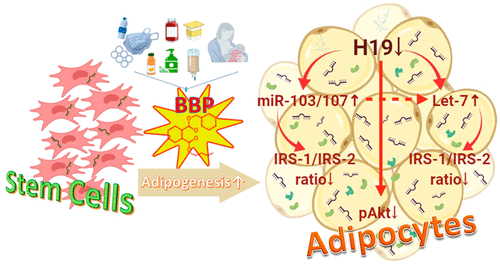当前位置:
X-MOL 学术
›
Chem. Res. Toxicol.
›
论文详情
Our official English website, www.x-mol.net, welcomes your feedback! (Note: you will need to create a separate account there.)
Benzyl Butyl Phthalate Induced Early lncRNA H19 Regulation in C3H10T1/2 Stem Cell Line
Chemical Research in Toxicology ( IF 4.1 ) Pub Date : 2021-01-04 , DOI: 10.1021/acs.chemrestox.0c00129 Jian Zhang 1 , Mahua Choudhury 1
Chemical Research in Toxicology ( IF 4.1 ) Pub Date : 2021-01-04 , DOI: 10.1021/acs.chemrestox.0c00129 Jian Zhang 1 , Mahua Choudhury 1
Affiliation

|
Exposure to endocrine-disrupting chemicals used in plastic manufacturing may contribute to the current obesity and diabetes epidemic. Our previous study demonstrated that benzyl butyl phthalate (BBP) induced adipogenesis in the C3H10T1/2 stem cell line. Here we investigated if BBP deregulated long noncoding RNA H19 and its downstream pathway and whether BBP plays a role in the insulin signaling pathway during adipocyte diiferentiation. Cells treated with an 8 day BBP regimen showed that H19 expression was decreased at day 2 with 50 μM BBP exposure (p < 0.05). However, no significant changes were observed from day 4 to day 8. Expression of miRNA-103/107, H19 regulated miRNAs, was upregulated at day 2 (p < 0.05) but not from day 4 to day 8. Similarly, expression of the let-7 family members (a, b, c, d, f, and g) was also significantly increased at day 2 (p < 0.05 or p < 0.01), except for let-7e. Both let-7 and miRNA-103/107 are targets of H19 and play roles in insulin signaling. Insulin receptor substrate (IRS)-1, one of the key insulin signal transduction regulators, was significantly downregulated from day 2 to day 8 (p < 0.05). Gene expression of insulin receptor (IR) and IRS-2 were not altered by BBP exposure. The ratio of IRS1/IRS2 was significantly decreased from day 2 to day 8. On day 4, phospho-Akt protein expression was significantly decreased (p < 0.05). In conclusion, BBP exposure may lead to metabolic dysregulation by altering vital epigenetic regulators such as lncRNA H19 and its target microRNAs at an earlier stage, which further regulates insulin signaling.
中文翻译:

苄基丁基邻苯二甲酸酯在 C3H10T1/2 干细胞系中诱导早期 lncRNA H19 调节
接触用于塑料制造的内分泌干扰化学品可能会导致当前的肥胖症和糖尿病流行。我们之前的研究表明,邻苯二甲酸丁苄酯 (BBP) 在 C3H10T1/2 干细胞系中诱导脂肪生成。在这里,我们研究了 BBP 是否解除了长链非编码 RNA H19 及其下游通路的调节,以及 BBP 是否在脂肪细胞分化过程中的胰岛素信号通路中发挥作用。用 8 天 BBP 方案处理的细胞显示,H19 表达在第 2 天与 50 μM BBP 暴露降低(p < 0.05)。然而,从第 4 天到第 8 天没有观察到显着变化。 H19 调控的 miRNA-103/107 的表达在第 2 天上调(p< 0.05),但不是从第 4 天到第 8 天。同样,let-7 家族成员(a、b、c、d、f 和 g)的表达也在第 2 天显着增加(p < 0.05 或p < 0.01),除了 let-7e。let-7 和 miRNA-103/107 都是 H19 的靶标,在胰岛素信号传导中发挥作用。胰岛素受体底物 (IRS)-1 是关键的胰岛素信号转导调节因子之一,从第 2 天到第 8 天显着下调(p < 0.05)。BBP 暴露不会改变胰岛素受体 (IR) 和 IRS-2 的基因表达。IRS1/IRS2比值从第2天到第8天显着降低。第4天,磷酸化Akt蛋白表达显着降低(p< 0.05)。总之,BBP 暴露可能通过在早期改变重要的表观遗传调节因子(如 lncRNA H19 及其靶标 microRNA)导致代谢失调,从而进一步调节胰岛素信号传导。
更新日期:2021-01-18
中文翻译:

苄基丁基邻苯二甲酸酯在 C3H10T1/2 干细胞系中诱导早期 lncRNA H19 调节
接触用于塑料制造的内分泌干扰化学品可能会导致当前的肥胖症和糖尿病流行。我们之前的研究表明,邻苯二甲酸丁苄酯 (BBP) 在 C3H10T1/2 干细胞系中诱导脂肪生成。在这里,我们研究了 BBP 是否解除了长链非编码 RNA H19 及其下游通路的调节,以及 BBP 是否在脂肪细胞分化过程中的胰岛素信号通路中发挥作用。用 8 天 BBP 方案处理的细胞显示,H19 表达在第 2 天与 50 μM BBP 暴露降低(p < 0.05)。然而,从第 4 天到第 8 天没有观察到显着变化。 H19 调控的 miRNA-103/107 的表达在第 2 天上调(p< 0.05),但不是从第 4 天到第 8 天。同样,let-7 家族成员(a、b、c、d、f 和 g)的表达也在第 2 天显着增加(p < 0.05 或p < 0.01),除了 let-7e。let-7 和 miRNA-103/107 都是 H19 的靶标,在胰岛素信号传导中发挥作用。胰岛素受体底物 (IRS)-1 是关键的胰岛素信号转导调节因子之一,从第 2 天到第 8 天显着下调(p < 0.05)。BBP 暴露不会改变胰岛素受体 (IR) 和 IRS-2 的基因表达。IRS1/IRS2比值从第2天到第8天显着降低。第4天,磷酸化Akt蛋白表达显着降低(p< 0.05)。总之,BBP 暴露可能通过在早期改变重要的表观遗传调节因子(如 lncRNA H19 及其靶标 microRNA)导致代谢失调,从而进一步调节胰岛素信号传导。



























 京公网安备 11010802027423号
京公网安备 11010802027423号